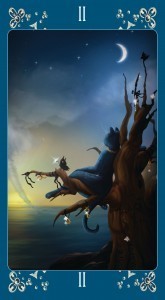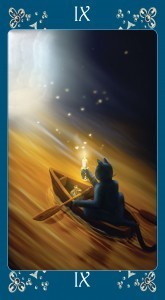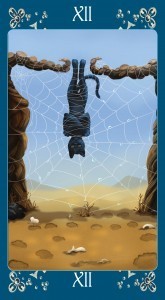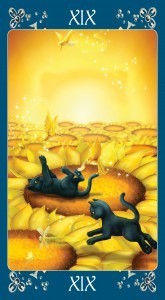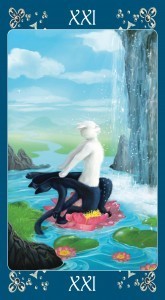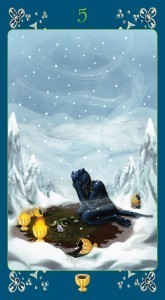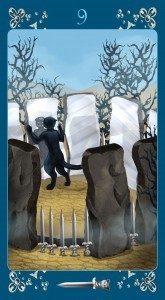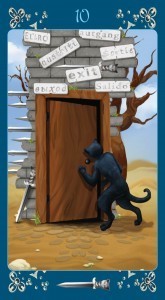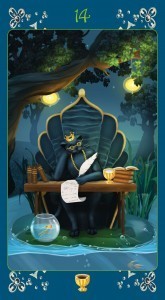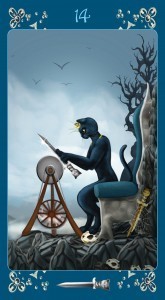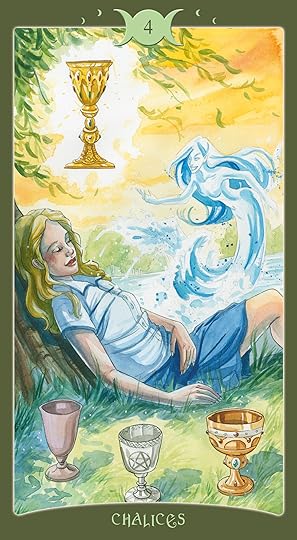Llewellyn Publications's Blog, page 89
May 21, 2013
The DMCA is a Challenge, Not a Curse
DMCA sounds like a strange Enochian entity that can be evoked through the use of weird tablets and strange, almost Cthuloid Calls into the beyond world of the dark night.
It’s not.
DMCA is short for the Digital Millennium Copyright Act. It was signed into U.S. law just before Samhain (hmmm), 1998, and basically strengthened copyright law enforcement and punishment. If you break copyright laws, it could be quite costly.
This has upset lots of people for a variety of reasons. Copyright is actually one of the few laws set up in the U.S. Constitution. Copyright is “the power to secure for limited times to authors the exclusive right to their writings.” (Wikipedia) In other words, if you write something original, you have the right to promote it and profit from it as you see fit without someone stealing it or claiming it as their own. That, to me, seems reasonable and fair.
The problem with the DMCA is that it doesn’t explicitly spell out what constitutes copyright law violation and what is “fair use.”
For example, if I were writing a book review and I quoted a brief passage of the book, that’s considered fair use and not a violation of copyright laws. If I used the exact same quotation in something I wrote, but I didn’t indicate that it was a quote or the source, that would be a copyright violation, and with the DMCA, that could be very costly, indeed.
One challenge to following copyright law is that writers are also readers. Imagine that you saw something in a book ten years ago and what you read becomes part of your thinking. Then, in a new book you write something that is similar to what you originally read without even crediting the source because you simply forgot it. That might be copyright infringement.
Might.
It’s legal to use some quoted words without getting permission to quote, but how many and for what purpose? Different authorities give different rules and one lawyer I read stated that the only way to know for sure was to try it, get sued, take it to court, and then, if necessary, take the decision all the way to the Supreme Court in order to set a precedent. That could cost hundreds of thousands of dollars, and in publishing, most books earn far less than that.
In reality, it’s safer and easier to ask the publisher of source material, if known, for permission to quote it. And that’s something that scares many potential new authors away from writing. “If I create a chapter that features a very important quote, what can I do if I can’t get permission to use the quote?”
Acquisitions at Llewellyn
As many of you reading this know, I am now an acquisitions editor at Llewellyn. We’re looking for new manuscripts all the time. We have usually promoted the use of limited quotes. We’re looking for your thoughts, not the thoughts of other writers.
More recently, we’ve begun looking for increasingly definitive and scholarly books. We’ve always done that, but it can be seen more in such books as those from Steven Skinner, some of the most important scholarly and practical occult books available anywhere. Recently, while working with the author of one of the books I’ve acquired for Llewellyn, I saw he had used extensive quotes and art of another author and artist. I told the him that getting permissions would be necessary and sent him forms he could use to obtain them. He was terribly worried—what if they wouldn’t give permission? I told him to try it and see what happens. A few weeks later I received an email. He was very excited because they had given him written permission to use the material and told him how to word the credits for their use. Now, his book is scheduled to be published.
Two Things to Note
There are twos things I want to point out on this. First, as the title of this post implies, the DMCA is a challenge, not a curse. And in fact, in many cases a few emails or letter is all that is required to get permission to use quotes and art. That makes sense. After all, if we list the originator and publication source we are literally giving free publicity to another product. They should want to give permission and have you achieve success. If you have an idea for a book but are worried about getting permission for quotes, get to work and start writing!
Second, books are not treated as either/or propositions. If you have a great idea for a book, start writing it. If you propose it and we like it, we’ll work with you to help you achieve a great book that is also successful. I’ll work with you to help you make it successful. If I acquire a book for Llewellyn I want it to be great because it’s my reputation on the line, too.
So, if you have an idea for a book, have started writing a book, or would like to see if we’re interested, please let me know. You can write to me at [email protected]. Let’s talk about it.
Possibilities
If you have a book or are just thinking about it and want to know more, there are basically three possible answers you could receive from us:
Yes, we’re interested.
We’re interested, but it needs more work.
Thanks, but it’s not something we can’t use right now.
If you don’t try, if you don’t bother contacting us, it’s the same as receiving answer number three. If you do contact us you’ve increased your possibility of being accepted or getting direction by more than 66%. So if you have a non-fiction occult book you’ve written, or are even just thinking about, let us know!
How to Submit or Query
Okay, you’ve written your book or you have a great idea. What do you do next? Whether you send your submission or proposal to us or another publisher, go to that publisher’s website and look for guidelines. To save you time, your submission to us should include the following:
A Cover letter containing a brief description of the project and the contents of the package.
If you’re making a proposal, include an outline and/or annotated table of contents.
A description of the intended market as it pertains to the subject matter including an explanation of why someone would want to buy the book.
Include a list of known competing titles and how yours differs. Include ISBNs if known.
A brief summary of the your background and credentials as related to the subject matter. That is, why are you qualified to write this book?
A full manuscript, if completed.
In the case of a proposal, at least three sample chapters.
Submissions must be in English, double-spaced with 1-inch margins in 12-point type.
Please use a common font such as Times or Helvetica.
Please number the pages and include a table of contents.
Complete permissions and citations. For more information please ask and I will send you more information and forms for your use.
Total word count for the proposed manuscript. Most of our manuscripts are at least 50,000 words. 55,000–60,000 words minimum is better.
Your complete daytime contact information including telephone and email.
That’s it! Most of these items are logical or technical. I’ve received some submissions without a title and without the author’s name. Don’t do that! Instead, send me your submission, and if it looks like it will be good for you and for us, let’s work together to share your book with people who are looking to learn what you know.
May 20, 2013
Black Cats Tarot
Right. I like RWS-style deck as well as the next person. I like cat decks pretty well (which is good, considering I designed the Pagan Cats Tarot) even though I am more of a dog person. I certainly did not expect to fall in love with the fabulous felines of the Black Cats Tarot. Seriously. In. Love.
I like novelty decks just fine. I like it better if a deck that could be novelty reaches further and achieves more. The Black Cats Tarot does that. I have picked out oodles of images that either charmed me or made me think or delighted me with their cleverness. I’ll comment on some, but I am sure these expressive creatures can speak for themselves.
This must be the most serene High Priestess that ever was:
I always thing the Hierophant gets a bad rap because so many of us project only negative aspects of leaders and teachers on that card. This one is more in line with my idea of a great spiritual leader and teacher.
The Hermit:
The Hanged Man:
Maybe the most joyful Sun I’ve seen since the Gaian Tarot:
Now tell me, what do you think of this World card?
A most poignant 5 of Cups:
Now here is an interesting 9 of Pentacles. It’s one thing to be self-possessed in your own garden. It’s another to be so while surrounded by sharks.
The 4 of Wands…it feels very pagan and magical; I love it.
A true 9 of Swords, don’t you think?
A clever and intriguing 10 of Swords:
I love the court cards.
Queen of Cups, not staring at the cup but at the heavens, where dreams and destinies are writ large!
King of Cups, a wordsmith or composer of songs? He is not the disconnected and repressed artist as often shown…he is an artist. Or perhaps he softens the rules and laws of his realm with compassion and empathy.
King of Swords. Perhaps this says more about me than I should admit in public, but I find this image kind of powerful, dangerous, and exciting.
May 17, 2013
The Hidden Factor of Magick
“Will this ritual or spell really work?”
There are really only two possible answer to this question: “No” or “I don’t know.”
There are some rituals and spells that have no rhyme or reason to them. They don’t work. Or at best you get something out of them in spite of the ritual. So in some cases, the answer as to whether a spell or ritual will work is simply, “No.”
But there are other instances where the spell or ritual is well designed and has worked for some people in the past. Logically, it should work for other people, but many times it simply doesn’t work. And that brings me back to the original question. The truth is, nobody cares whether a ritual or spell will work. What they really want to ask is, “Will this ritual or spell really work for me?” And the only honest answer is that “I don’t know.”
I don’t know what your background in magick is.
I don’t know what your skill level at magick is.
I don’t know what influences are going on in your life that might have an effect on your magick.
I don’t know what other people are doing that might affect the result.
I don’t know if your heart is into it and if you really want to achieve this magickal goal.
As readers of my blog and my books know, I consider magick to be an art and a science. From the scientific point of view I’d have to say there are just too many variables to give you a positive and rational response that any particular act of magick will definitely work for you.
All Other Things Being Equal…
So let’s narrow down the variables. Let’s say you have several years of practice at magick and you really want to achieve the goal of the ritual. Let’s also say that everything seems to be done correctly—from the design of the ritual and the performance of a divination, in this case using the Tarot, before the ritual (and getting all positive cards) to having all of the correct magickal tools and performing the rite during the appropriate magickal hour. Is it now possible to say, “Yes, the ritual or spell will really work for you?”
No.
Two people could eliminate all of the variables and the magick might only be successful for one person and not the other. It’s unfair. I know. But why does it work for one person and not for the other? I call the answer the Hidden Factor of Magick.
Realization of the Nature of the Hidden Factor
Years ago, I was having some terrible problems with my neck. It was causing lots of pain. Every time I turned my head it sounded like a bowl of cereal going snap, crackle, and pop.
At the time, a friend of mine, I’ll call her “Bianca,” was living at my apartment. Bianca had been in an abusive relationship and I was providing her a place to stay until she could get back on her feet. She had previously received her 1st Reiki attunement and, seeing the pain I was in, offered to help me.
I sat in a chair and she placed her hands on my shoulders near my neck. That’s all. She did not tell me to expect any particular experience. In fact, I was somewhat skeptical about Reiki.
In a short time I started to feel energy flows moving up from the bottom tip of my spine through my neck and out the top of my head. It was as if there were a roaring waterfall flowing up. I started to perspire heavily. This went on for the fifteen minutes or so she worked Reiki on me. At the conclusions I was much better. After two more treatments I was fine and have not had any problems with my neck since.
Now, consider this. If someone simply put their hands on my shoulders, there is no reason to expect that there would be any change. In fact, I’ve had people put their hands on my shoulders and nothing like my experience with Bianca has occurred.
Something other than the use of the hands had an effect on me. And I think that the answer is, something was going on in her mind.
Putting hands on the shoulders didn’t cause the change. Rather, it was the ritual action combined with mental activity that resulted in the change.
I contend the same is true with magick: wand waving and reading bad poetry using mispronounced foreign words—as I’ve witnessed far too often—is only bad theater. Performing powerful ritual actions with accurately spoken/vibrated/chanted appropriate passages is good theater. It is only when something in the mind links actions and words that the result is powerful magick.
The Hidden Factor Revealed
So what is this Hidden Factor that combines with actions and words to make magick happen. At first look, it would seem like passion is the factor. If you don’t really want your magickal goal, if you’re not passionate about it, the magick doesn’t work. As it says in book II, chapter 13, of The Sacred Magic of Abramelin the Mage:
…commence your Prayer with fervor, for then it is that you will begin to enflame yourself in praying, and you will see appear an extraordinary and supernatural Splendour which will fill the whole apartment, and will surround you with an inexpressible odour, and this alone will console you and comfort your heart so that you shall call for ever happy the Day of the Lord.
So it’s not just the passion (praying with fervor), it’s what results from the passion (being enflamed). So what happens when you become focused on one thing and are praying with fervor? You achieve an alternate state of consciousness (ASC). This particular state is currently referred to as a peak experience, which Wikipedia defines as “a kind of transpersonal and ecstatic state, particularly one tinged with themes of euphoria, harmonization and interconnectedness.”
There are a variety of ways to achieve this ASC. Dancing, chanting, drumming, breathwork, exercise, meditation, sexual activity, and more may all achieve this ASC. May.
The problem is, sometimes they will help you achieve an ASC and sometimes it’s just a dance.
There is, however, a way to achieve this particular ASC every time. It’s through the use of hypnosis. There’s just one small catch…
You Can’t Handle the Truth!
Most people, especially thought who don’t get in-person training in hypnosis (or are trained by someone who actually was never properly trained) learn the type of hypnotic “induction” known as Progressive Relaxation or Progressive Muscle Relaxation. The technique is very simple: you progressively tell your body, starting at the feet and moving to the head (or vice versa), to relax. It takes a long time to do this properly, over 20–30 minutes or longer. And at the end of it you are…deeply relaxed.
There’s nothing wrong with being deeply relaxed. It’s a good thing! But being deeply relaxed is not the same things as the ASC known as the hypnotic state. And the truth is that many people who believe they have been hypnotized have only been in a relaxed stated.
In fact, although hypnosis is most often accompanied by relaxation, it doesn’t require relaxation at all. The deep relaxation resulting from this exercise can be used as a means to lead someone, including yourself, into a hypnotic state, but it’s not hypnosis. In Modern Magick I describe it as the “Relaxation Ritual.”
It’s Only Natural
Although real hypnosis is an ASC, it’s one of the most natural things in the universe. We all go in and out of hypnotic states many times during the day. Television induces a hypnotic state. That’s why advertisers will pay so much to have you watch the same commercial on TV. It’s literally putting a post hypnotic suggestion into your mind. Reading a good book, listening to great music, or watching an exciting movie cause you to become absorbed in those activities: they put you in a hypnotic state.
So the question is, if that usual, “Let your toes gently relax” induction doesn’t necessarily result in hypnosis, what can you do? Well, you can go to a good hypnosis training. They range in price from under $100 to several thousand dollars. Alternatively, you can read some of the books listed HERE.
Hypnosis is not the only ASC or only way to achieve an ASC that changes actions and words into magick. However to my knowledge it is the only one that has been well researched and can achieve an ASC quickly and effectively on a consistent basis.
By the way, I also support getting trained in person if you want to learn Reiki. However, there are some great books you can get to help you begin to learn Reiki. You can find them HERE.
Dreaming with the 4 of Cups
The Book of Shadows Tarot, volume 2: So Below is now available!
This morning, I shuffled my deck, fresh from the box and drew a card for this entry. The 4 of Cups:
Now, I would have wanted a card that I considered “more positive” than the 4 of Cups. But this caused me to reconsider the card. Maybe it’s not all bad…I the Rider-Waite-Smith version, the man is clearly dissatified. His ideal is making him unhappy with his lot. This woman seems to be dreaming Muse-Inspired dreams. Is this good or bad? Will she achieve these new dreams or will they only cause her to be bitterly disappointed with what she already has? Is this Water Muse trustworthy, giving a blessing, or more like a Siren from Greek mythology, leading her into dangerous territory.
May all your dreams and daydreams today lead to you fulfillment and satisfaction.
May 15, 2013
I Saw Your Future And He’s Not It Author Louise Helene on Examiner.com
Check out a fascinating interview with 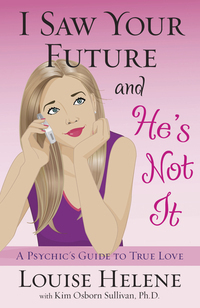 I Saw Your Future And He’s Not It author Louise Helene on Examiner.com, detailing her book and relationship advice for landing and keeping Mr. Right.
I Saw Your Future And He’s Not It author Louise Helene on Examiner.com, detailing her book and relationship advice for landing and keeping Mr. Right.
Examiner.com launched in April 2008, providing informative and entertaining content with over 100,000 contributors. Examiner.com is a top 100 website, reaching over 37 million unique visitors a month.
Visit Examiner.com to read the full interview.
Haunted Route 66 Author Richard Southall on Examiner.com
Check out a fascinating interview with  Haunted Route 66 author Richard Southall on Examiner.com, detailing his new book and the research he conducted while writing it (as well as a peek behind the scenes of his earlier book, How to Be a Ghost Hunter).
Haunted Route 66 author Richard Southall on Examiner.com, detailing his new book and the research he conducted while writing it (as well as a peek behind the scenes of his earlier book, How to Be a Ghost Hunter).
Examiner.com launched in April 2008, providing informative and entertaining content with over 100,000 contributors. Examiner.com is a top 100 website, reaching over 37 million unique visitors a month.
Visit Examiner.com to read the full interview and check out a cool slide show of Richard and his haunted travels.
May 14, 2013
Mibramig Magical Tarot
My Experience with the Mibramig Magical Tarot
In case you missed the Llewellyn Journal article, click HERE to learn more about this interesting deck.
May 13, 2013
My Rosicrucian Adventure
Well, sort of.
This strange adventure took place many years ago when I was attending UCLA. At the time, there had been a spate of books that were republished about Atlantis and Lemuria. This happens every 20 or so years. Being a contrarian (I was in college…what do you expect?), I looked for a more unusual book on Lemuria. The book I selected was Lemuria: The Lost Continent of the Pacific by Wishar Spenle Cerve. It turns out that the author’s odd name is an anagram of Harve Spencer Lewis, late Imperator of the AMORC Rosicrucians. The book was also published by AMORC, so I consider this to be my Rosicrucian adventure.
The book offers a some of the strangest stories about the supposed continent of Lemuria, sort of the equivalent of Atlantis but located in the Pacific ocean. According to the book, direct descendants of the original Lemurians were still alive and living in gigantic caves beneath California’s Mt. Shasta. They apparently came out at night and only rarely during the day. People living in the area saw odd lights and an occasional strange-looking person coming to buy supplies, but they kept quiet about it. I wanted to investigate for myself.
It was Spring Break, and I talked my girlfriend, whom I’ll call “Cindy Favor,” into using her VW camper van conversion and driving north to Mt. Shasta. Cindy and I had met in music classes at UCLA and ended up having an on-again off-again relationship for years. This time it was, of course, on, so we drove from Los Angeles up to the mountain. We stopped in Cindy’s home of Los Gatos and spent the night, visiting with her mother.
The next day we completed the drive up to Mt. Shasta. We arrived in the last town before starting up the mountain, Weed (!), around 3:00 p.m. It was just the beginning of the tourist season and few restaurants were open. We found a little place that was definitely a tourist trap. We ordered a plain pizza. The lady gladly took our money before taking the pizza out of a freezer and tossing it into a toaster over. She hadn’t removed the wrapper and had to pry it off after it was heated.
If you ever want a pizza that tastes like cardboard with ketchup coated with American cheese and the flavor of plastic, you can buy it in Weed. We were very hungry so we each had a piece but threw the rest away.
There was one grocery store in town that was still open. A major chain, the vegetables and fruits were all wilted and the cheese was moldy in packages. We picked what we could, along with boxes of crackers, and started the drive up Mt. Shasta.
VW conversion vans had very poor power, and the poor vehicle struggled up the mountain. We drove up and up as the night began to fall. We eventually went off road into the forest. The snow was still visible in places and what had melted left the ground rather soft. I was driving, and found a large clearing that would just take the weight of the camper. The clearing was about 40 feet across and formed a ragged circle. I parked in the middle.
It was cold, and we hadn’t bought wood to make a fire. We just had warm jackets. We watched the night skies and sang songs. Cindy accompanied us on guitar. It was pleasant and intimate. Without a fire, we could hear the sounds of small creatures and insects. We watched the mountain below us, looking for unusual lights. There was only darkness. Around midnight we unfolded the camper’s bed and went to sleep.
A Visit From…?
It was a few hours later when I roused from my sleep. I realized something wasn’t right. A window was slightly open for air, and I noticed the silence. No animal noises. No insect sounds. It was perfectly quiet.
Too quiet.
Suddenly, the entire van started to shake. It wasn’t like an earthquake; I’d been through several of those living in southern California. It was more like a large, incredibly strong creature was at the side of the camper, shaking it back and forth, trying to rip open the side of the van and get in!
The shaking lasted for about 20 seconds, maybe longer. And then…it was over. Bugs immediately began to make noises again and small animals could be heard scurrying through the trees. Apparently, whatever had shaken us was gone.
Cindy and I were both sitting up, breathing heavily and fast. Our hearts were racing. Finally, she spoke: “Take the flashlight and see what shook us.”
“I’m not going out there,” I said. “You go out there.”
“You’re the man,” she pouted. “You’re supposed to do stuff like that.”
I knew that acting like a frightened girl was far from Cindy’s nature. “You’re the liberated woman,” I said. “You go check it out.”
Finally, she stuck a flashlight in my hand and demanded I check to see what happened.
I struggled into some clothes and shoes, and slid open the side door. Cindy huddled under the covers. I looked around. There was nothing to be seen. I walked once around the camper. There was nothing within 20 feet of the vehicle.
I shone the flashlight down toward the ground. Although the ground was soft enough for me to leave footprints, and easily soft enough to show the footprints of any animal strong enough to shake the van, there were no footprints other than my own!
What Was It?
I got back in the camper and closed the door. I told Cindy what I had seen. We locked the doors and didn’t sleep for the rest of the night. Our plan had been to spend several days camping on different parts of the mountain. Instead, when the light came up, we checked the grounds once more. There were no footprints other than our own. Nothing led to or from the van. There were no marks on the top of the dirty van. We decided to leave and drove back down the mountain.
So what was it? Was it a Lemurian threatening us into leaving the mountain? I don’t think so. AMORC, it turns out, had published an article in their privately circulated magazine several years earlier stating that all the Lemurians had left. This didn’t get the circulation of the book, and they kept printing editions of the book without including that the Lemurians had left the mountain. A bear would have left tracks. I don’t think a mountain lion could have made a leap of 20 feet from the trees to the van and then another leap of 20 feet from the van back to the trees. I also don’t think it was a large bird as it would have left marks on the top of its landing zone.
There have been Bigfoot sightings on Mt. Shasta, but that gives me even more questions. If a Bigfoot did shake the van, how did it get from the edge of the clearing to the camper without leaving any tracks, and how did it get support to shake the van without leaving marks in the soft earth or on the vehicle? The same is true for space aliens or trans-dimensional travelers.
To this day, I have no idea what it was. I just call it My Rosicrucian Adventure.
May 10, 2013
Hammer of Thor now VA accepted symbol of faith
 April was a hard month, news-wise, but May has been bringing one bit of good news after another. The latest is the surprising addition, without much fanfare, of Thor’s Hammer to the list of approved religious symbols for Armed Forces memorials, headstones and graves.
April was a hard month, news-wise, but May has been bringing one bit of good news after another. The latest is the surprising addition, without much fanfare, of Thor’s Hammer to the list of approved religious symbols for Armed Forces memorials, headstones and graves.
As you can see on the National Cemetery Administration’s list of Available Emblems of Belief for Placement on Government Headstones and Markers, the Hammer of Thor is proudly displayed as number 55. It was six years ago on April 23, 2007 that the Wiccan pentacle was approved, and there have not been any new additions of Pagan symbols (such as the Awen) until now despite the efforts of groups like the Pagan Headstone Campaign.
The proper name of Thor’s hammer is Mjölnir, or “crusher,” and it’s said to be infallible, never missing its mark and always returning to Thor. It was created in response to one of Loki’s infamous bets: he bet his head that two dwarves could not possibly make finer objects than some rival dwarves, they proved him wrong by crafting this hammer. The only reason he was not beheaded was that he did not include his neck as part of the bargain, so they couldn’t remove his head. (That Loki!) He did get his mouth sewn shut in punishment, but the upswing is that Thor got an awesome new weapon out of the deal. The Hammer of Thor has been worn for centuries as a symbol of the people’s devotion to their gods.
I haven’t seen a formal press release on behalf of whoever fought this battle and got it approved, but if I find out anything I will keep you posted. If you know, please feel free to contact me or comment below.
Congratulations to all Heathens and Asatruars – this is a big step of recognition for your community!
May 9, 2013
I Feel the Need…the Need for Speed!
I have conflicting views on spellbooks.
One one level, I think they’re fantastic. They give you a complete and simple ritual which can be powerful and effective.* On the other hand, they often imply that all you have to do is read some words, chant a spell, burn a colored candle, and Ta Da! the magick happens.
Only for most people, it doesn’t.
In my experience, most people who try various simple magicks don’t have much luck. I realize there will be some people reading this who will write in saying, “But it worked for me!” and that’s fantastic. However, that’s what’s called anecdotal evidence. Merely because it worked for you doesn’t mean it’s going to work for everyone…or even for anyone else. Spellbooks can work, but for most people today they don’t. And to explain why, I need to tell you about Ed Sullivan.
Ed Sullivan
World-Telegram photo by Ed Palumbo
Sullivan (1901–1974) began his career as a newspaper sports writer and became a columnist writing on theater and gossip. Later he was on radio, in movies, and, in 1948, began a TV variety show. It ran on Sunday nights until 1971. He introduced American audiences to many dozens of performers, including crossing the color barrier by having numerous African-American acts as well as “British Invasion” music acts. If you were an up and coming act, you wanted to appear on Sullivan. It was also ideal for famous acts looking to publicize an appearance or a new album. Sullivan included bands, dancers, specialty acts, and comedians.
Comedians back then were quite different from what you most often see today. They would take a lot of time to set up a joke and then pow! hit you with the punchline. A five minute act might have only four or five jokes. Today, a comedian trying an act like that would be booed off the stage. Today we feel a need for speed. Bam! Bam! Bam! One-liner jokes right after another. This extends to so many areas of life. Instead of sitting down for a meal we drive through a restaurant and eat while we drive. Movies require fast cuts and jerky action sequences. A large number of people who watch TV can’t just watch TV, they do something else at the same time. Everything has to be fast, fast, fast.
And that’s the way many people want their magick.
Instant Magick?
I like the idea of magick happening quickly. The issue I have is that many people want the study and practice they put into magick to take place quickly, too. Just read a book and do a spell and Pow! that magick should happen. It usually doesn’t.
One of my favorite books that sounds like it supports the idea of just do the spell and the magick occurs is Instant Magick by Christopher Penczak. As he points out, candles, special ingredients and exotic symbols are important in performing many types of magick, but these items aren’t always practical, attainable or even available. After all, “You can’t always get to your altar, and many times you need magick in your car, at work or on the run.” 
He goes on to explain that simple magick doesn’t mean you can do it without training. “Instant Magick is not a quick book of spells that requires no energy, effort or imagination. Instant Magick is not one quick, easy-open package designed to make your life perfect with a few herbs, crystals, or candles. Magick doesn’t work that way, though we often wish it would.” He goes on to say that there are three things you need to study, practice, and learn to do so you can access them at a moment’s notice. They are:
Alter your consciousness
Have a clear intention
Know how to work with your magickal energy
Once you have such skills, you can use them, instantly—perhaps with the help of a spellbook—to create magick.
In The Magical Life of Scott Cunningham (An ebook available from the Kindle Store (LINK), Kobo (LINK), Sony (LINK), and through the iTunes store for just $1.99) I share Scott’s ideas on this, too. I quote him from The Truth About Witchcraft Today, where Scott wrote:
My latest, most refined definition [of magic] is: Magic is the projection of natural energies to produce needed effects.
here are three main sources of this energy—personal power, earth power, and divine power.
Personal power is the life force that sustains our earthly existences. It powers our bodies. We absorb energy from the moon and sun, from water and food. We release it during movement, exercise, sex, and childbirth. Even exhaling releases some power, though we recoup the loss through inhaling.
In magic, personal power is aroused, infused with a specific purpose, released, and directed toward its goal.
Earth power is that which resides within our planet and in its natural products. Stones, trees, wind, flames, water, crystals, and scents all possess unique, specific powers that can be used during a magical ritual.
A Wiccan may dip a quartz crystal in salt water to cleanse it and then press it against an ailing person’s body to send its healing energies within. Or, herbs may be sprinkled around a candle that is burned to produce a specific magical effect. Oils are rubbed onto the body to effect internal changes.
Divine power is the manifestation of personal power and earth power. This is the energy that exists within the Goddess and God—the life force, the source of universal power that created everything in existence.
Wiccans invoke the Goddess and God to bless their magic with power. During ritual they may direct personal power to the deities, asking that a specific need be met. This is truly religious magic.
And so, magic is a process in which Wiccans work in harmony with the universal power source that we envision as the Goddess and God, as well as with personal and earth energies, to improve our lives and to lend energy to Earth. Magic is a method whereby individuals under none but self-determined predestination take control of their lives.
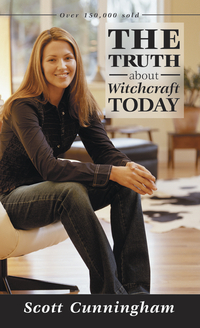 Like most people today, I feel the need for speed. I want my magick to manifest quickly and powerfully. Most people who pick up their first spellbook want that, too. In my experience magick can occur quickly and be very effective if you understand what drives it and makes it work. That means avoiding the curse of speed and taking your time to develop your magickal skills. If you’re willing to take the time and practice, you can perform magick quickly and effectively. If not, your word mumbling and wand waving may accomplish nothing.
Like most people today, I feel the need for speed. I want my magick to manifest quickly and powerfully. Most people who pick up their first spellbook want that, too. In my experience magick can occur quickly and be very effective if you understand what drives it and makes it work. That means avoiding the curse of speed and taking your time to develop your magickal skills. If you’re willing to take the time and practice, you can perform magick quickly and effectively. If not, your word mumbling and wand waving may accomplish nothing.
It’s like someone we’ve never heard of suddenly becoming famous. “Instant fame,” it’s called. Only during interviews we learn that this person spent years studying, training, practicing, and honing their craft. Spellbooks, then, are great, if you bring to them the skills necessary to work with the spells. To accomplish speedy, effective magick we usually need to have spent lots of time preparing to do that magick. I believe it’s time well spent.
*Well, some of them can. Some are based on traditions that have proven effective over time and others have been tried and proven effective by the person who writes them down. On the other hand, some spells and rituals are dreamed up by a person and because the person thinks the spell should work, he or she assumes that it will work. Too often, this is not the case. Discernment—using experience, training, and study to separate what is from what is not valid—is a valuable tool of the magician.
Llewellyn Publications's Blog
- Llewellyn Publications's profile
- 241 followers


